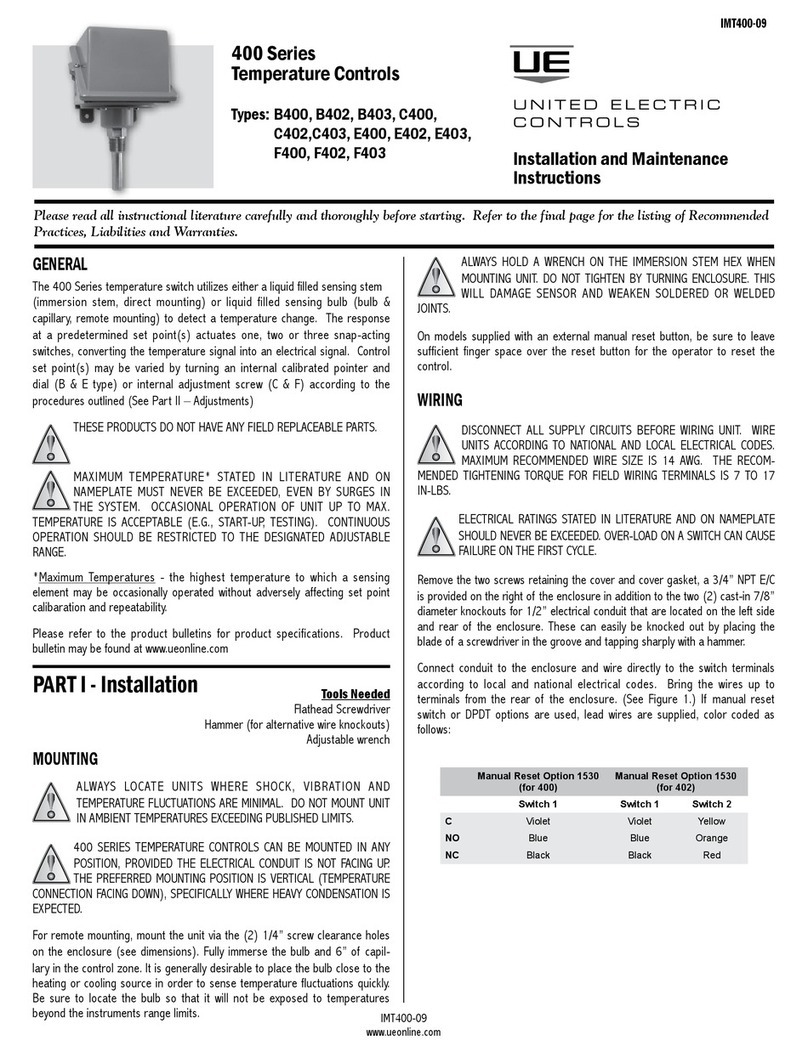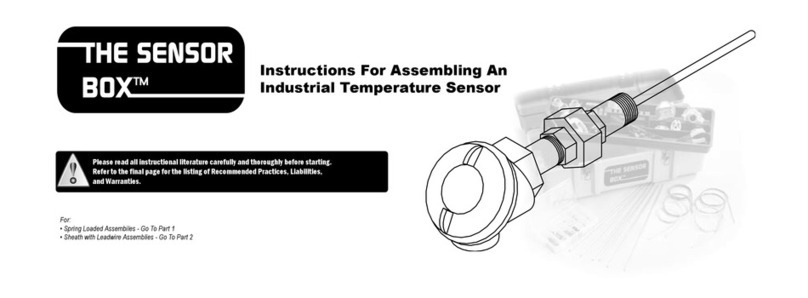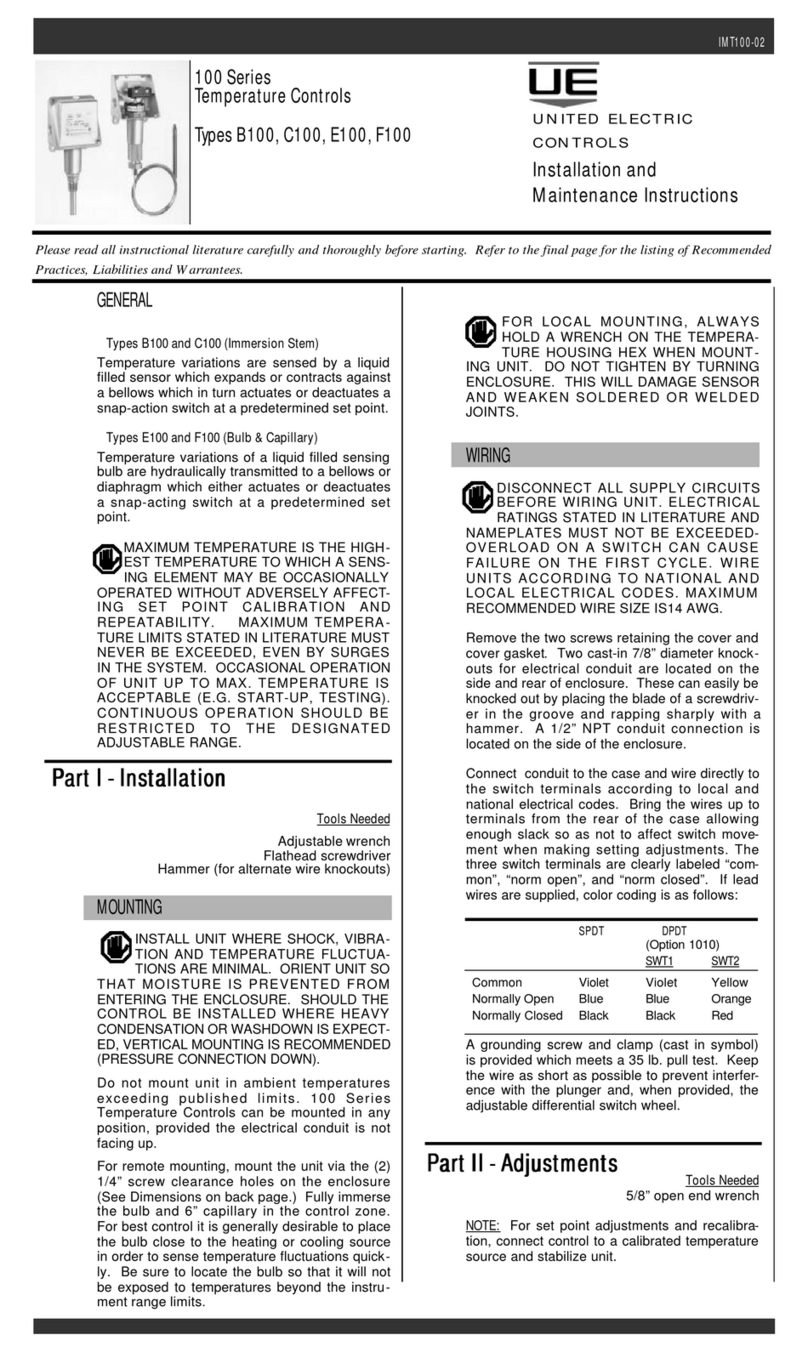
IM800-06
www.ueonline.com CP05111500
RECOMMENDED PRACTICES AND WARNINGS
United Electric Controls Company recommends careful consideration of the following factors when
specifying and installing UE pressure and temperature units. Before installing a unit, the Installation
and Maintenance instructions provided with unit must be read and understood.
• Toavoiddamagingunit,proofpressureandmaximumtemperaturelimitsstatedinliteratureand
on nameplates must never be exceeded, even by surges in the system. Operation of the unit up
to maximum pressure or temperature is acceptable on a limited basis (e.g., start-up, testing) but
continuous operation must be restricted to the designated adjustable range. Excessive cycling at
maximum pressure or temperature limits could reduce sensor life.
• Aback-up unitis necessaryforapplicationswhere damageto aprimaryunit couldendanger
life, limb or property. A high or low limit switch is necessary for applications where a dangerous
runaway condition could result.
• Theadjustablerangemustbeselectedsothatincorrect,inadvertentormalicioussettingatany
range point cannot result in an unsafe system condition.
• Installunitwhereshock,vibrationandambienttemperaturefluctuationswillnotdamageunitor
affect operation. Orient unit so that moisture does not enter the enclosure via the electrical con-
nection. When appropriate, this entry point should be sealed to prevent moisture entry.
• Unitmustnotbealteredormodifiedaftershipment.ConsultUEifmodificationisnecessary.
• Monitor operation to observe warning signs of possible damage to unit, such as drift in set
point or faulty display. Check unit immediately.
• Preventativemaintenanceandperiodictestingisnecessaryforcriticalapplicationswheredam-
age could endanger property or personnel.
• Forallapplications,afactorysetunitshouldbetestedbeforeuse.
• Electricalratingsstatedinliterature andonnameplate mustnotbeexceeded.Overloadona
switch can cause damage, even on the first cycle. Wire unit according to local and national
electrical codes, using wire size recommended in installation sheet.
• Donotmountunitinambienttemp.exceedingpublishedlimits.
LIMITED WARRANTY
Seller warrants that the product hereby purchased is, upon delivery, free from defects in material and
workmanship and that any such product which is found to be defective in such workmanship or mate-
rial will be repaired or replaced by Seller (Ex-works, Factory, Watertown, Massachusetts. INCOTERMS);
provided, however, that this warranty applies only to equipment found to be so defective within a period
of 24 months from the date of manufacture by the Seller. Seller shall not be obligated under this war-
ranty for alleged defects which examination discloses are due to tampering, misuse, neglect, improper
storage, and in any case where products are disassembled by anyone other than authorized Seller’s
representatives. EXCEPT FOR THE LIMITED WARRANTY OF REPAIR AND REPLACEMENT STATED ABOVE,
SELLER DISCLAIMS ALL WARRANTIES WHATSOEVER WITH RESPECT TO THE PRODUCT, INCLUDING ALL
IMPLIED WARRANTIES OF MERCHANTABILITY OR FITNESS FOR ANY PARTICULAR PURPOSE.
LIMITATION OF SELLER’S LIABILITY
Seller’s liability to Buyer for any loss or claim, including liability incurred in connection with (i) breach
of any warranty whatsoever, expressed or implied, (ii) a breach of contract, (iii) a negligent act or acts
(or negligent failure to act) committed by Seller, or (iv) an act for which strict liability will be inputted to
seller, is limited to the “limited warranty” of repair and/or replacement as so stated in our warranty of
product. In no event shall the Seller be liable for any special, indirect, consequential or other damages
of a like general nature, including, without limitation, loss of profits or production, or loss or expenses
of any nature incurred by the buyer or any third party.
UE specifications subject to change without notice.
UNITED ELECTRIC
CONTROLS
180 Dexter Avenue, P.O. Box 9143
Watertown, MA 02471-9143 USA
Telephone: 617 926-1000 Fax: 617 926-2568
http://www.ueonline.com
























